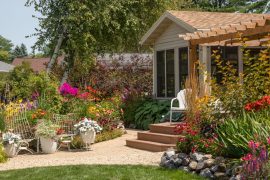By Hannah Wente | Photography by Hillary Schave
Gardening is a labor of love — especially when a couple tackles a verdant landscape together. Whether it’s lovingly restoring acres of prairie land or transforming a desolate urban lot, two area couples regularly pour their hearts and souls into their gardening dreams, strengthening spousal bonds in the process.
PRAIRIE FOLK
Jan Froelich and Bob Novy of Verona bought 92 acres of land in Clyde, roughly an hour west of Madison, shortly after they were married in 2010. They share a passion for restoring land.
“We were both very interested in not necessarily perennial gardens, but native prairie plants and restoring prairie and restoring woodlands,” says Froelich.
The couple’s inspiration came from their neighbor, John Barnes, who owns 200 acres next to their residence near Verona. Novy helped Barnes do prairie burns and other land management activities, which inspired the couple to take on similar projects on their own land.
“We named the property Stars Aligned Ridge,” says Novy. “That’s kind of our thing from when we met. It’s our big labor of love — we just chip away at it.”
Forty-five of their 92 acres could be prairie, and they’ve “finished” 12 acres, working on about 2 to 4 acres at a time. They started with a kill-all-weeds approach, but now use a lighter touch to knock back invasive grasses so the prairies can open up to new seed. The entire process takes five to seven years to resemble a prairie. It involves sowing seeds in the fall and winter and then mowing the first and second years of growth. Burning ideally happens in the spring of the third year of growth. A prairie burn helps to reduce nitrogen content, which is unfavorable for weeds, but tolerated by native prairie plants.
“We plant a prairie,” Froelich says, “and it’s literally going to look like weeds for the first couple of years — but you just have to keep nurturing it, and eventually burning it.”
They use a mix of local, state and federal programs to cover equipment, time and seed costs. Grants force them to tackle new projects, such as converting woods to native oak savannah.
Working the land takes up 75-90% of their free time. If they weren’t equally passionate, their relationship wouldn’t survive.
“We get very tired from all the work we do, but it’s awesome, and we’re seeing the rewards now,” says Novy.
Their dream master plan includes building a retirement house on the land this winter or next spring.
“We put a driveway to the top of this ridge, and it’s a gorgeous view of the Driftless Area,” says Froelich. “That’s going to be where we are for the rest of our lives.”
A HIDDEN URBAN OASIS
August is Nancy and Fred Risser’s favorite month. It’s when everything in their gardens are in full bloom. The longest- serving state legislator and his wife garden a spectacular 3,000-square-foot property in the heart of downtown Madison, as well as well as 11 guerrilla gardens, which are gardens on nearby neglected land.
“We had about an acre of land on Risser Road in Indian Hills, where we lived before moving downtown to our condo right across from the Capitol,” says Nancy. “We loved gardening there, but we realized that as we were getting older it was going to be something we were going to try to keep up [with].”
Their current garden is nestled behind apartment buildings and student housing off of Blair and Johnson streets, accessible only by driveways and secret pathways.
They have a lifetime license to use the fenced-in, 3,000-square-foot property, which also has water access and a shed. That’s because a downtown developer wanted a small house Fred owned on Johnson Street for a project.
“It was two years before he got [the house] from us,” says Fred. “He didn’t get it until he was able to give us some gardening space.”
Partly in exchange for the house, the Rissers got a degraded parking lot on Blair Street.
“It was really a mess,” says Fred. “We took over a parking lot that had a lot of cars and junk and turned it into a beautiful garden. It takes a little while and it takes a little work.”
Rehabbing a polluted lot hasn’t been easy. After attempting to plant multiple Japanese maple trees in a particularly icky spot, they found that a gingko tree thrived in the space. Gingko trees are able to grow despite polluted air and soil.
“We had to dig out a lot of the earth and get fresh soil in there for the trees and flowers,” says Fred. It took six inches of topsoil, and annual additions of soil, mulch and fertilizers. All the effort has made the soil not only workable, but very productive, according to Nancy.
“We covered up the chain link fence with wisteria vines with hanging bracts of purple flowers, honeysuckle vine and a series of bushes,” says Nancy. “One is called rose abelia and the other, one of my favorites, is calycanthus — a very tropical smelling flower. It smells like a piña colada!”
They worked with Steve Lesch of Landscape Designs, LLC to develop plans for the garden, including a berm for a rock garden in the center. He and his team planted the arbor vitaes, Japanese maple and cherry trees around the periphery of the property.
The Rissers have hosted garden tours along with their landscape architect Steve Lesch for Olbrich Gardens, the Madison Symphony Orchestra and multiple community groups.
“[It’s a] labor of love … it’s never a chore,” says Nancy. “Every day that we’re able to be down there, we are.”



